

December 2011 NewsletterISSN: 1933-8651
In this issue we present the following articles, news, announcements, and reviews:
|
Articles, Essays, and Reports
News and Announcements
Call for Papers and Fellowships
Book Review
|
Editors' Corner -- Dialogues Across the Diasporas:
Intersectional Discourse and the ADAN

As scholars of the African Diaspora we comprehend the complexities of our field: centuries of muted voices uncovered by the archaeological record, politics of representation and narrative, intersections of power, privilege and oppression. Understanding these textures requires multifaceted perspectives and interdisciplinary approaches. As the new editors of the ADAN we each bring a particular academic training and intellectual focus to our work, and will transfer these lenses into the future trajectory of this journal. One of the many challenges of our discipline is to figure out how to push the scholarly parameters and think more complexly about life across the Diaspora. These sorts of cross disciplinary approaches will nurture what the late Dr. VeVe Clark (1991) coined as "diaspora literacy." The material record is always in conversation with the social world, thus reminding us to keep these discussions open. This December’s newsletter reflects our want to reach out of the soil and into broader cultural spaces, while not neglecting our archaeological foundation. We hope our direction encourages further interdisciplinary inquiries and enriches our diaspora literacies so that we can continue to mend the cultural mosaic of the African Diaspora.
Reference: VeVe Clark, "Developing Diaspora Literacy and Marasa Consciousness" in Hortense Spillers, ed. Comparative American Identities: Race, Sex, and Nationality in the Modern Text (New York: Routledge, 1991), 40-61.
[Return to table of contents]
Introduction to an Extract from War of the Pews:
A Personal Account of the St. Augustine Church
in New Orleans, by Rev. Jerome G. LeDoux, S.V.D.
By Christopher N. Matthews
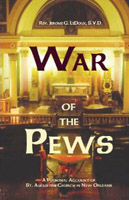
In 1998, as director of the University of New Orleans' Greater New Orleans Archaeology Program, I had the opportunity to meet Rev. Jerome LeDoux, pastor of the historic St. Augustine church located in the Tremé section of New Orleans. I went with Bettie Pendley, a preservationist and archaeological advocate, to appeal to Father LeDoux to allow us to test the churchyard for archaeological remains of an early colonial house that stood there until the early 1900s. I was also hoping to convince Father LeDoux to work with us to develop a public archaeology program that would allow the project to reach out and connect with the surrounding Tremé community. This was a time when public archaeology was becoming increasingly common, and the St. Augustine site seemed a very good place to do it.
Tremé is a neighborhood with deep roots in the city, and many connections to the city's diverse and important African American community. The colonial house that stood at the site was first built in the 1710s as the home of the Company of the Indies brick maker, Charles Morand. The workforce at the site consisted of enslaved Africans owned by the company under Morand's supervision. Morand later owned the brick works and its laborers independently. By the 1790s, the property was owned by Claude Tremé, who started subdividing the land, naming the new neighborhood after himself. [Read or download this full article here in Adobe .pdf format >>>].
[Return to table of contents]
Crocodiles: From Katsina to Madagascar
By Wendy Wilson Fall
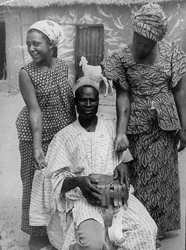
Crocodiles? They seem to have followed me, across continents, through time, from the desert to cities and to the island of Madagascar and back.
I had a crocodile etched into my arm as a tattoo. As a graduate student and the only (to my knowledge) American student at Ahamdu Bello University in Zaria, in northern Nigeria I’d been studying local tattoos. I was a student of the sublime and graceful culture of the Fulani nomads of that area. Every morning, an extension agent from the Agricultural department would pick me up at Amina Hall girls’ dormitory and take me out of the (then) small town of Zaria to a Fulani encampment about ten miles from the city limit. Although I had begun in Art History, focusing on creating a sort of visual encyclopedia of the Fulani’s different tattoos, I was actually sliding over to anthropology without realizing it. Sensing that recording the form and name of tattoos was not enough, I had managed to get a double major approved, and so was also registered in the Department of Sociology. I wanted to know who who wore what, where and why – and at that time, it was the sociologists at A.B.U who would help me expand my inquiry in those directions. In the Fine Arts department, I continued my drawings and etchings on zinc sheets for prints of Fulani women and men with their tattoos.
The tattoos are blue. There are special ones for the face, for the back, for legs (calves), even the neck. Although some of the more elaborate ones are now gone out of fashion, village girls still do get them, in northen Nigeria and across the border in south-central Niger. I was doing my major research with Fulani people of the Katsina clans, the Ba’en specifically, and their favorite symbol was the crocodile. The crocodile was an important symbol for the region of Katsina, an ancient sign referring back to a time when they were plentiful in the rivers that web the north, tributaries of the great Niger River. In fact, the name of the city of Kaduna, then the regional capital, means crocodiles, and refers to the large population of crocodiles that inhabited the rivers in that area. [Read or download this full article here in Adobe .pdf format >>>].
[Return to table of contents]
New Windows on the Past: An Analysis of Glass
Artifacts from New Philadelphia, Illinois
By Courtney Ng

Archaeological research at New Philadelphia, Illinois, the mid-nineteenth century site of the first town planned in advance and legally registered by an African American, has revealed a remarkable wealth of material remains. While a good deal of research has been carried out on artifacts ranging from ceramics to faunal remains, this study contributes to this multi-year, collaborative project by providing a comprehensive analysis of glass artifacts. This project is a result of my experience as a field school participant at the site. Through a discussion of glass artifact frequency across the site, including its distribution, types of glass recovered, and manufacturing techniques present in the artifacts, I hope to understand when these artifacts were deposited and where they originated from. The resulting study sheds light on the overwhelming presence of late nineteenth and early twentieth century glass artifacts which post-date the McWorter era, opening the potential for future research into this time period and providing further evidence for New Philadelphia's continued existence long after its legal status as a town ended. [Read or download this full article here in Adobe .pdf format >>>].
[Return to table of contents]
New Outlets for Old Foundations:
Archaeology in Annapolis and Web-based Outreach
By Beth Pruitt, Kathryn Deeley and Mark Leone
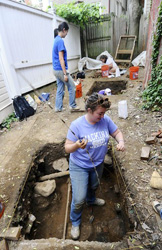
Archaeology in Annapolis is excavating two homes lived in by African Americans. One, the James Holliday House, was owned by a free African American family since 1850 and is still in Holliday family hands. This is unique in Annapolis. The other was lived in by African Americans and Filipinos and is our first effort to explore Filipino Americans in Annapolis. How can we share the archaeology?
In the summer of 2011, we extended our findings into the virtual realm. The sites where Archaeology in Annapolis excavators focused this summer -- private properties in Annapolis and on the Eastern Shore -- would otherwise remain inaccessible to the public eye (see SHA Winter 2011 and CHENA Fall 2011 newsletters for more information on the summer field school). In the 2011 field season, the excavations, under the direction of Mark P. Leone, used blogging and social media to connect with a wider audience. Due to the accessibility of the Internet, blogging has become a powerful tool within academia to educate and communicate with students, other academics, and the interested public. Our blog created a space to share experiences and discoveries while allowing feedback from the community in a digital environment, and welcomed exchange not only with the community that is physically local, but also with a dispersed community of shared interests. [Read or download this full article here in Adobe .pdf format >>>].
[Return to table of contents]
Rio's Cemetery of "New Blacks"
Sheds Light on Horrors of Slave Trade
By Tom Phillips
The Guardian
Posted online December 21 2011 by the Guardian at
http://www.guardian.co.uk/world/2011/
dec/20/rio-cemetery-of-the-new-blacks-brazil
Copyright 2011 The Guardian.
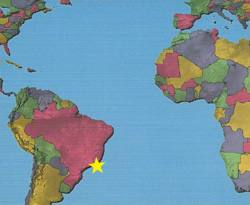 Tooth analysis shows Africans taken from wide area ranging from Sudan in the north-east to Mozambique in the south
Tooth analysis shows Africans taken from wide area ranging from Sudan in the north-east to Mozambique in the south
Locals called it the "cemetery of the new blacks," but in truth it wasn't much of a cemetery. Devoid of headstones, wreaths or tearful mourners, this squalid harbourside burial ground was the final resting place for thousands of Africans shipped into slavery.
The new world greeted them with a lonely death in an unfamiliar land.
For decades the cemetery and those buried there between 1760 and 1830 were forgotten, hidden under layer after layer of urban development.
But 15 years after the cemetery's fortuitous discovery -- during the renovation of Petrucio and Ana de la Merced Guimaraes's family home when builders unearthed a series of muddy skeletons -- academics now believe they have evidence of the true reach of the slave trade.
The study of teeth from 30 partial skeletons has hinted that slaves arriving in Rio – many of whom were sold on to work in coffee and sugar plantations or gold mines – came from a much wider geographical region than once thought.
Archaeologists and anthropologists studying bone and tooth fragments are shedding light on the horrors of a trade that saw at least 3 million slaves shipped from Africa to Brazil between 1550 and 1888, when the practice was officially abolished.
"It was ugly: a dump into which bodies were thrown and burned," said Sheila Mendonça de Souza, a bio-archaeologist studying the cemetery in Rio de Janeiro, once one of the busiest slave ports in the Americas.
"People weren't buried in tombs, they were tossed away into mass graves."
Della Cook, a biological anthropologist from the University of Indiana working on the burial ground, said: "There is a lot of scholarship on slave cemeteries and the slave trade in North America but very little in South America, which is one of the things that makes this site fascinating.
"We have historical records but we haven't been able to look before at the people themselves."
Using strontium isotope analyses of tooth enamel -- a technique that helps detect where a person was raised and has previously been used on samples from burial sites in the Caribbean and Mexico -- academics were able to confirm the large area from where the "new blacks" came.
"What we got was essentially the entire range of strontium isotope values," said Cook. "It surprised us that the spectrum was so broad."
The results indicated that slavers had "waded way into the interior" of Africa rather than restricting their search to coastal areas, Cook added. [Read this full article at The Guardian online >>>].
[Return to table of contents]
End of Archaeological Surveys Hides History, Some Say
By Robert Behre
The Post & Courier
Posted online December 11 2011 by the Post & Courier at
http://www.postandcourier.com/news/
2011/dec/11/how-much-is-still-out-there/
Copyright 2011 The Post & Courier.
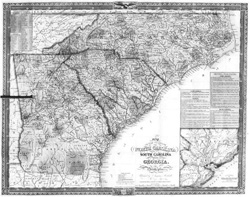
State regulators no longer require developers along South Carolina's coast to do routine archaeological surveys, and some say the state will lose an unknown amount of its history as a result.
The change -- which took effect during the past year -- stemmed from discussions between the S.C. Department of Health and Environmental Control's Office of Coastal Resource Management and the State Historic Preservation Office.
The previous policy had led to the discovery of many historic sites, such as the village of Childsbury in Berkeley County, said L.M. Drucker, an archaeologist with AF Consultants in Columbia.
Childsbury was built around Strawberry Ferry Landing, a hub of Colonial commerce that once had a racetrack, free school, a tavern and doctors' and lawyers' offices.
All that remains above ground today is a chapel, but Drucker said her archaeological work in the mid-1990s found deposits of artifacts underground that ultimately helped thwart a housing development there and led to the state's purchase of the land.
"The coast is such a primary area for historic settlement and it's getting developed so much, it's a shame," she said of the change. "It's awful for the state to allow that much heritage to go down the tubes."
Only known sites protected -- The policy change has been in the works for a few years, prompted in part by developers' concerns about the application process, said Dan Burger, OCRM spokesman.
In the eight-county coastal zone -- Beaufort, Hampton, Jasper, Colleton, Dorchester, Charleston, Georgetown and Horry -- developers must obtain OCRM land disturbance permits.
They still must address archaeological sites if their property is known to contain any such sites on or eligible for the National Register of Historic Places. But they now may skip this step if there's no documentation. . . .
When DuPont expanded its plant in Berkeley County, OCRM didn't require a survey, but DuPont did one in anticipation, Dobrasko said. That peremptory survey found a significant site -- the slave quarters for Dean Hall plantation. Its excavation formed the basis for an exhibit at Cypress Gardens. [Read this full article at The Post & Courier online >>>].
[Return to table of contents]
Archaeology Field Schools in 2012
St. Mary's will be holding its biennial field school in The Gambia this coming summer, and is currently beginning advertising for a January 27, 2012 application deadline.
W. E. B. Du Bois Archaeological Heritage Field School, July 11 to August 17, 2012. University of Massachusetts Amherst, Department of Anthropology.
[Return to table of contents]
Kimbwandende Kia Bunseki Fu-Kiau, an Exceptional Scholar
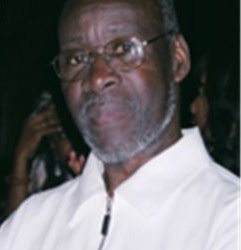
Prof. Kimbwandende Kia Bunseki Fu-Kiau has provided exceptional scholarship on the history and cultures of the Kongo region and its people, including books such as African Cosmology of the Bantu-Kongo (Athelia Henrietta Press/Orunmila, 2001), Simbi-Simbi: Hold Up That Which Holds You Up (Dorrance Publishing, 2007), and Mbongi: An African Traditional Political Institution (Afrikan Djeli Publishers, 2007). Dr. Fu-Kiau is now experiencing considerable health problems and related expenses. Prof. Kenneth B. Nunn of the University of Florida's College of Law has established a fund-raising portal to help out with these challenges. You can contribute online through a pay-pal interface at www.kapipal.com/fu-kiau, or if you prefer to send a contribution by check, please mail it to Kenneth Nunn, P.O. Box 357041, Gainesville, FL 32635.
From Prof. Nunn's Kapipal page -- Fu-Kiau "has lectured on African concepts of reality and African spiritual practices throughout Africa, Europe, the United States, the Caribbean and South America. He is one of the great elders of the African family and a true gift to humanity. Currently, Dr. Fu-Kiau is facing a serious health challenge. After several months in the hospital, he is now convalescing in a Boston nursing home. He owes thousands of dollars in medical and other bills generated while he was in the hospital. There is also an urgent need to help pay transportation expenses to allow his family and friends to get to Boston and provide the kind of loving and supportive care he needs at this critical time."
[Return to table of contents]
New Book
The Materiality of Freedom:
Archaeologies of Postemancipation Life
Edited by Jodi A. Barnes
University of South Carolina Press,
Cloth, 291 pp., ISBN-13: 978-1611170344, 2011.
Description from the Publisher:
 The Materiality of Freedom uses the lens of archaeology to provide original perspectives on the painful Reconstruction and Jim Crow eras by studying the material culture inherent in the struggles for racial equality in America and the Caribbean. Editor Jodi A. Barnes and a cast of notable scholars focus their essays on racial and social strife experienced by African Americans seeking to exercise their newly won civil rights following the Civil War. By studying material objects in a variety of contexts, archaeologists enrich historical narratives and offer grounded insights on the racial and social strife experienced by people of African descent. Building on the body of literature on African American archaeology, the twenty-two contributors to this volume use historical records, maps, and artifacts to examine the material-culture dimensions of churches, cemeteries, plantations, communities, neighborhoods, and towns.
The Materiality of Freedom uses the lens of archaeology to provide original perspectives on the painful Reconstruction and Jim Crow eras by studying the material culture inherent in the struggles for racial equality in America and the Caribbean. Editor Jodi A. Barnes and a cast of notable scholars focus their essays on racial and social strife experienced by African Americans seeking to exercise their newly won civil rights following the Civil War. By studying material objects in a variety of contexts, archaeologists enrich historical narratives and offer grounded insights on the racial and social strife experienced by people of African descent. Building on the body of literature on African American archaeology, the twenty-two contributors to this volume use historical records, maps, and artifacts to examine the material-culture dimensions of churches, cemeteries, plantations, communities, neighborhoods, and towns.
The contributors to this collection assert that exploring the disheartening past of African Americans is essential to understanding contemporary issues of race and power as they delve into the archaeology of places such as the Harriet Tubman Home, the Phyllis Wheatley Home for Girls, Boston Saloon, and Alexandria, Virginia's Contrabands and Freedmen's Cemetery. Urban archaeology methods are also applied to prominent areas of Auburn, New York, Chicago, and the Old Salem Historical District in Winston-Salem. The Materiality of Freedom bridges past and present with community-based research and a combination of archaeological method and theory to highlight contemporary issues of class, gender, race, and social inequality. As these essays open new vistas on the social construction of race and racism, they also demonstrate a more hopeful view on the building of black communities and in the United States and the Caribbean.
[Return to table of contents]
New Book
The Creolizing Subject:
Race, Reason, and the Politics of Purity
By Michael J. Monahan
Fordham University Press,
Cloth, 247 pp., ISBN-13: 9780823234509, 2011.
Description from the Publisher:
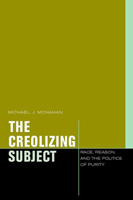 How does our understanding of the reality (or lack thereof ) of race as a category of being affect our understanding of racism as a social phenomenon, and vice versa? How should we envision the aims andmethods of our struggles against racism? Traditionally, the Western political and philosophical tradition held that true social justice points toward a raceless future-that racial categories are themselves inherently racist, and a sincere advocacy for social justice requires a commitment to the elimination or abolition of race altogether. This book focuses on the underlying assumptions that inform this view of race and racism, arguing that it is ultimately bound up in a politics of purity-an understanding of human agency, and reality itself, as requiring all-or-nothing categories with clear and unambiguous boundaries. Racism, being organized around a conception of whiteness as the purest manifestation of the human, thus demands a constant policing of the boundaries among racialcategories.Drawing upon a close engagement with historical treatments of the development of racial categories and identities, the book argues that races should be understood not as clear and distinct categories of being but rather as ambiguous and indeterminate (yet importantly real) processes of social negotiation. As one of its central examples, it lays out the case of the Irish in seventeenth-century Barbados, who occasionallyunited with black slaves to fight white supremacy-and did so as white people, not as nonwhites who later became white when they capitulated to white supremacy. Against the politics of purity, Monahan calls for the emergence of a creolizing subjectivitythat would place such ambiguity at the center of our understanding of race. The Creolizing Subject takes seriously the way in which racial categories, in all of their variety and ambiguity, situate and condition our identity, while emphasizing our capacity, as agents, to engage in the ongoing contestation and negotiation of the meaningand significance of those very categories.
How does our understanding of the reality (or lack thereof ) of race as a category of being affect our understanding of racism as a social phenomenon, and vice versa? How should we envision the aims andmethods of our struggles against racism? Traditionally, the Western political and philosophical tradition held that true social justice points toward a raceless future-that racial categories are themselves inherently racist, and a sincere advocacy for social justice requires a commitment to the elimination or abolition of race altogether. This book focuses on the underlying assumptions that inform this view of race and racism, arguing that it is ultimately bound up in a politics of purity-an understanding of human agency, and reality itself, as requiring all-or-nothing categories with clear and unambiguous boundaries. Racism, being organized around a conception of whiteness as the purest manifestation of the human, thus demands a constant policing of the boundaries among racialcategories.Drawing upon a close engagement with historical treatments of the development of racial categories and identities, the book argues that races should be understood not as clear and distinct categories of being but rather as ambiguous and indeterminate (yet importantly real) processes of social negotiation. As one of its central examples, it lays out the case of the Irish in seventeenth-century Barbados, who occasionallyunited with black slaves to fight white supremacy-and did so as white people, not as nonwhites who later became white when they capitulated to white supremacy. Against the politics of purity, Monahan calls for the emergence of a creolizing subjectivitythat would place such ambiguity at the center of our understanding of race. The Creolizing Subject takes seriously the way in which racial categories, in all of their variety and ambiguity, situate and condition our identity, while emphasizing our capacity, as agents, to engage in the ongoing contestation and negotiation of the meaningand significance of those very categories.
[Return to table of contents]
New Book
John Brown Still Lives! America's
Reckoning With Violence, Equality, and Change
By R. Blakeslee Gilpin
University of North Carolina Press,
Cloth, 304 pp., ISBN-13: 9780807835012, 2011.
Description from the Publisher:
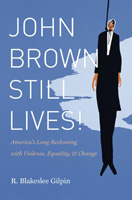 From his obsession with the founding principles of the United States to his cold-blooded killings in the battle over slavery's expansion, John Brown forced his countrymen to reckon with America's violent history, its checkered progress toward racial equality, and its resistance to substantive change. Tracing Brown's legacy through writers and artists like Thomas Hovenden, W. E. B. Du Bois, Robert Penn Warren, Jacob Lawrence, Kara Walker, and others, Blake Gilpin transforms Brown from an object of endless manipulation into a dynamic medium for contemporary beliefs about the process and purpose of the American republic.
From his obsession with the founding principles of the United States to his cold-blooded killings in the battle over slavery's expansion, John Brown forced his countrymen to reckon with America's violent history, its checkered progress toward racial equality, and its resistance to substantive change. Tracing Brown's legacy through writers and artists like Thomas Hovenden, W. E. B. Du Bois, Robert Penn Warren, Jacob Lawrence, Kara Walker, and others, Blake Gilpin transforms Brown from an object of endless manipulation into a dynamic medium for contemporary beliefs about the process and purpose of the American republic.
Gilpin argues that the endless distortions of John Brown, misrepresentations of a man and a cause simultaneously noble and terrible, have only obscured our understanding of the past and loosened our grasp of the historical episodes that define America's struggles for racial equality. By showing Brown's central role in the relationship between the American past and the American present, Gilpin clarifies Brown's complex legacy and highlights his importance in the nation's ongoing struggle with the role of violence, the meaning of equality, and the intertwining paths these share with the process of change.
[Return to table of contents]
New Book
Kentucky Rising: Democracy, Slavery, and the
Culture From the Early Republic to the Civil War
By James A. Ramage and Andrea S. Watkins
University of Kentucky Press,
Cloth, 480 pp., ISBN-13: 9780813134406, 2011.
Description from the Publisher:
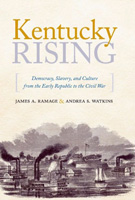 Kentucky's first settlers brought with them a dedication to democracy and a sense of limitless hope about the future. Determined to participate in world progress in science, education, and manufacturing, Kentuckians wanted to make the United States a great nation. They strongly supported the War of 1812, and Kentucky emerged as a model of patriotism and military spirit.
Kentucky's first settlers brought with them a dedication to democracy and a sense of limitless hope about the future. Determined to participate in world progress in science, education, and manufacturing, Kentuckians wanted to make the United States a great nation. They strongly supported the War of 1812, and Kentucky emerged as a model of patriotism and military spirit.
Kentucky Rising: Democracy, Slavery, and Culture from the Early Republic to the Civil War offers a new synthesis of the sixty years before the Civil War. James A. Ramage and Andrea S. Watkins explore this crucial but often overlooked period, finding that the early years of statehood were an era of great optimism and progress. Drawing on a wealth of primary and secondary sources, Ramage and Watkins demonstrate that the eyes of the nation often focused on Kentucky, which was perceived as a leader among the states before the Civil War. Globally oriented Kentuckians were determined to transform the frontier into a network of communities exporting to the world market and dedicated to the new republic. Kentucky Rising offers a valuable new perspective on the eras of slavery and the Civil War.
[Return to table of contents]
New Book
Exhibiting Blackness:
African Americans and the American Art Museum
By Bridget R. Cooks
University of Massachusetts Press,
Paperback, 240 pp., ISBN-13: 9781558498754, 2011.
Description from the Publisher:
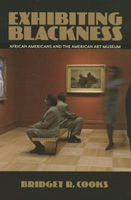 In 1927, the Chicago Art Institute presented the first major museum exhibition of art by African Americans. Designed to demonstrate the artists' abilities and to promote racial equality, the exhibition also revealed the art world’s anxieties about the participation of African Americans in the exclusive venue of art museums -- places where blacks had historically been barred from visiting let alone exhibiting. Since then, America's major art museums have served as crucial locations for African Americans to protest against their exclusion and attest to their contributions in the visual arts.
In 1927, the Chicago Art Institute presented the first major museum exhibition of art by African Americans. Designed to demonstrate the artists' abilities and to promote racial equality, the exhibition also revealed the art world’s anxieties about the participation of African Americans in the exclusive venue of art museums -- places where blacks had historically been barred from visiting let alone exhibiting. Since then, America's major art museums have served as crucial locations for African Americans to protest against their exclusion and attest to their contributions in the visual arts.
In Exhibiting Blackness, art historian Bridget R. Cooks analyzes the curatorial strategies, challenges, and critical receptions of the most significant museum exhibitions of African American art. Tracing two dominant methodologies used to exhibit art by African Americans -- an ethnographic approach that focuses more on artists than their art, and a recovery narrative aimed at correcting past omissions -- Cooks exposes the issues involved in exhibiting cultural difference that continue to challenge art history, historiography, and American museum exhibition practices. By further examining the unequal and often contested relationship between African American artists, curators, and visitors, she provides insight into the complex role of art museums and their accountability to the cultures they represent.
[Return to table of contents]
New Book
Funerals in Africa: Explorations of a Social Phenomenon
Edited by Michael Jindra and Joel Noret
With a foreword by Jan Vansina
Berghahn Books,
Paperback, 264 pp., ISBN-13: 9780857452054, 2011.
Description from the Publisher:
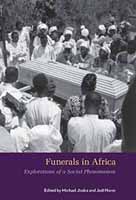 Across Africa, funerals and events remembering the dead have become larger and even more numerous over the years. Whereas in the West death is normally a private and family affair, in Africa funerals are often the central life cycle event, unparalleled in cost and importance, for which families harness vast amounts of resources to host lavish events for multitudes of people with ramifications well beyond the event. Though officials may try to regulate them, the popularity of these events often makes such efforts fruitless, and the elites themselves spend tremendously on funerals. This volume brings together scholars who have conducted research on funerary events across sub-Saharan Africa. The contributions offer an in-depth understanding of the broad changes and underlying causes in African societies over the years, such as changes in religious beliefs, social structure, urbanization, and technological changes and health.
Across Africa, funerals and events remembering the dead have become larger and even more numerous over the years. Whereas in the West death is normally a private and family affair, in Africa funerals are often the central life cycle event, unparalleled in cost and importance, for which families harness vast amounts of resources to host lavish events for multitudes of people with ramifications well beyond the event. Though officials may try to regulate them, the popularity of these events often makes such efforts fruitless, and the elites themselves spend tremendously on funerals. This volume brings together scholars who have conducted research on funerary events across sub-Saharan Africa. The contributions offer an in-depth understanding of the broad changes and underlying causes in African societies over the years, such as changes in religious beliefs, social structure, urbanization, and technological changes and health.
[Return to table of contents]
Dave the Potter, Dave Drake
Edited collection By Michael Chaney
The editor invites chapter proposals for an edited collection exploring the work of Dave the Potter, or David Drake (ca. 1800-1874), a nineteenth-century African American slave and potter who worked in Edgefield, South Carolina. In addition to making some of the largest hand-built pottery of the period, Drake incised writing onto his storage jars and pots—signatures, proverbs, couplets of poetry, and witticisms. Some of this writing is documentational, but much of it isproverbial and poetic. Overtly disobeying prohibitions against slave literacy, these inscriptions range in tone from the audacious ("I made this jar" or "Cash Wanted") to the absurd ("Making this Jar–I Had All Thoughts / Lads & Gentlemen–Never Out Walks"). Save for a few commentators, such as craft historian John Vlach, journalist and fiction writer Leonard Todd, McKissick Museum curator Jill Beute Koverman, and my own chapter in Fugitive Vision (Indiana, 2008), Davethe Potter and the implications of his art and writing have hardly been discussed by the scholarly community. This collection is an attempt to rectify that scarcity of commentary.
Possible topics include:
-- Dave the Potter as subject of contemporary art and writing in Leonard Todd's Carolina Clay, or Laban Carrick Hill and Bryan Collier's award winning children's book Dave the Potter, or Chicago artist Theaster Gates's exhibit and installation "To Speculate Darkly."
-- Dave's place in a revamped art history or literary canon of the US, of South Carolina, of African Americans, or of the Diaspora
-- Comparisons of Dave and other artisans, artists, or writers
-- Dave's work as the site for an intervention into theories or methods of critical race studies, history, art history, slave signatures, diasporic archeology, inscriptions, poetry, heroic couplets, hybridity, pottery, colonoware,ceramic form, notions of interdisciplinarity, fungibility, canonicity, Diaspora, etc.
-- Analyses (from a range of approaches) of Dave's poetic inscriptions as well as his vessels.
This list is more suggestive than exhaustive: the editor and the university presses interested in this collection welcome a range of topics, approaches, and disciplines.
Queries should be submitted to michael.chaney@dartmouth.edu. Please send 400-600 word proposals as well as a C.V. to the same email address by March 1st 2012. Completed chapter-essays for accepted proposals will be due by June 1st 2012.
[Return to table of contents]
Eurotast Fellowships
EUROTAST -- A Marie Curie Initial Training Network on the History, Archaeology and New Genetics of the Transatlantic Slave Trade. Thirteen PhD Fellowships in history, archaeology, bioarchaeology, social anthropology, genetics and bioinformatics.
EUROTAST is a new European-funded research network that will bring together an unprecedented range of young researchers to examine the history of the transatlantic slave trade and to explore its long-term effects. As part of the project, we are currently hiring 13 Early Stage Researchers to work on various projects relating to the slave trade. Each Fellowship is equivalent to a 3-year fully funded PhD position and must commence on 1 May 2012. The successful applicants will be recruited from a wide range of disciplines including history, archaeology, social anthropology, genetics and bioinformatics and will be based at 10 partner institutions across Europe. By bringing together researchers from these various fields, we will generate new data that will add to our knowledge of how the slave trade operated and how it impacted the lives of millions of people. For more details on the individual projects please visit our website at www.eurotast.eu or contact us at enquiries@eurotast.eu.
Academic Requirements -- Eligible applicants for the ESR Fellowships (equivalent to a PhD position) must be in possession of a Master’s or Bachelor’s degree, in a relevant field. However, individual departments and universities will have their own specific entry requirements. Eligibility criteria set by the European Union for Marie Curie ESR fellowships require that the applicants have no more than 4 years research experience prior to the envisaged starting date.
Marie Curie ITN mobility requirement -- Researchers can be nationals of any country other than the country of the premises of the host organisation where they will carry out their project. However, the ESR Fellowships only cover the fee levels for EU citizens, not those for students from outside the EU. At the time of the selection, applicants must not have resided or carried out their main activity (work, studies, etc.) in the country where their Fellowship is to be held for more than 12 months in the 3 years immediately prior to the starting date of the fellowship.
Application process -- Please note that applications are welcomed from any qualified applicants, regardless of gender, ethnicity or country of origin, but will only be considered if eligibility requirements are met and the application guidelines are strictly adhered to. Applicants should send a full CV, a short cover letter outlining briefly why they are suitable for the position(s), and the names of 2 referees to applications@eurotast.eu. For full details on how to apply please visit our website at www.eurotast.eu. Deadline for applications is 31 January 2012.
[Return to table of contents]
Book Review
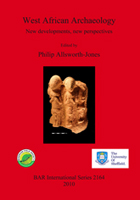
Philip Allsworth-Jones, editor. West African Archaeology: New Developments, New Perspectives. British Archaeological Reports, BAR S2164, 2010. 170 pp., Paperback, ISBN: 9781407307084.
Reviewed for the African Diaspora Archaeology Newsletter by Abidemi Babatunde Babalola, Rice University
This book is a collection of papers presented in a one-day conference organized by the editor at the University of Sheffield on June 27th 2009. As reflected from the title of the book, West African Archaeology: New Developments, New Perspectives, and the overall objective of the conference, the volume is aimed to "discuss the new discoveries and providing an update on certain key topics" issues in the archaeology of West Africa. In addressing this, the book is divided into fifteen chapters with each chapter or group of chapters focusing on a particular topic in African archaeology with much emphasis on West Africa. The editor added an introductory section, which does very well in capturing the discussions that unfold in the conference and the essence of each paper in the volume. Although the volume does not an in depth detail on each of the thematic subject, yet over the entire text is an important volume that shows how new archaeological studies are and should be directed in West Africa. [Read or download this full review here in Adobe .pdf format >>>]
[Return to table of contents]

©2011 African Diaspora Archaeology Network
Copyright and all rights reserved by
individual authors for each article.
Please send comments, suggestions,
or questions to the editors
Last updated: December 29, 2011
Text only menuSearch
|



